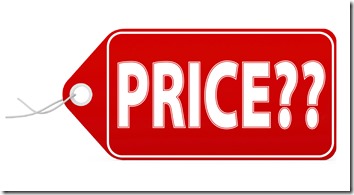How to price your products
 I blogged a few years ago about how to price your time I thought I should blog about how to price a physical product.
I blogged a few years ago about how to price your time I thought I should blog about how to price a physical product.
Recently, I've been involved in setting up a new company selling all sorts of Christmas decorations, artificial trees and more called Festive Sparkle. Part of setting up any business is setting a price for the items you plan to sell.
Pricing a physical product is a little different to how you would price your time but there are similar factors that you have to take into account. At the very least you should factor the following into your calculations:
- [COST] The original cost of the item
- [BUYTAX] Any taxes incurred for buying the product
- [STORAGE] The cost of storing the item before it's sold (whether this is a garage, shop, warehouse etc)
- [BREAK] A margin for breakages, returns etc
- [MARGIN] A margin to make some money
- [WIGGLE] A margin to allow for discounts
- [SELLTAX] Any taxes incurred for selling the product
If your products (and market) allow for it then I would ensure your margins allow for at least a 15% discount. Personally I would include that in the [WIGGLE] if you can as you ideally need to sell your items and make some money!
This then gives you a nice formula to start off with:
Actual Cost = ([COST]+ [BUYTAX]) + [STORAGE]
Minimum Sell Price = [Actual Cost] + [BREAK] + ([MARGIN] + [WIGGLE]) + [SELLTAX]
Depending on your situation, the storage cost may not be that easy to calculate. In an ideal world you'd sell all your stock but realistically you are likely to have some stock left so if it doesn't have a shelf life (i.e. eggs, bread etc) so you can break it down: firstly into an annual cost and then into a per item charge.
Calculate the total cost of your storage for your items for a year. If your cost is directly attributable to all your stock, be pessimistic and calculate it on having 50% of your stock for an entire year (so if you had 100 items, each costing £1 a year to store, your rough storage cost will be: ((100 / 2) * 1) = £50). This is a very rough calculation but it should give you a baseline to start with. Once you have the total cost of annual storage, spread that cost all your products - so your £100 of stock will cost £150 over the year.
Breakages are often forgotten about but it's an actual cost that needs to be factored in. Depending on your product, you may not get breakages or accept returns but I would still factor in at least a 1% return rate to be safe.
You also want to give thought to the cost of shipping, if you're thinking about offering free shipping on the items then you will need to factor that in as well.
To help, I've put together a little spreadsheet you can use. You can download my product pricing spreadsheet here.
I hope that helps someone, if I've forgotten something else, let me know.
Finally, if you're selling items that are the same as ones sold by others e.g. branded goods then you obviously need to give consideration to the price that your competitors are using, if your prices are way off then perhaps you need to think of another product to sell?
A quick example
So, if I bought 100 items at £1 each, the cost of storage was 1p per item per day, I needed to factor in a 2% breakages/return rate, 15% discount and a 10% margin with tax at 20%, the numbers would look like this:
Item storage cost: ((100 / 2) * (£0.01 * 365) = £1.83
Actual Cost: (£1.00 + £0.20) + £1.83 = £3.03
Cost Of All Breakages: £3.03 * (100 * 0.02) = £6.05
Cost inc Breakages: £3.03 + (£6.05 / 100) = £3.09
Cost inc Margin: £3.09 + (£3.09 * 0.10) = £3.39
Cost inc Wiggle: £3.39 + (£3.39 * 0.15) = £3.90
Minimum Sell Price: £3.90 * 1.20 = £4.68
So for an item that you purchased for £1.00, you'd need to sell it for £4.68 but this is a slightly simplistic as it doesn't factor in the other costs to sell the item (all of which you would need to factor in).
Liked this post? Got a suggestion? Leave a comment